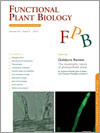Ver ítem
- xmlui.general.dspace_homeCentros Regionales y EEAsCentro Regional Buenos Aires NorteEEA San PedroArtículos científicosxmlui.ArtifactBrowser.ItemViewer.trail
- Inicio
- Centros Regionales y EEAs
- Centro Regional Buenos Aires Norte
- EEA San Pedro
- Artículos científicos
- Ver ítem
Expression profile of transcripts encoding cell wall remodelling proteins in tomato fruit cv. Micro-Tom subjected to 15°C storage
Resumen
To extend fruit market life, tomatoes are harvested before red ripe and kept at temperatures below optimum (20°C). In this work, Micro-Tom tomatoes stored at 20°C (normal ripening) were compared with those stored at 15°C or 4°C (chilling injury inducer) for 7 days. In contrast to 4°C, storage at 15°C delayed ripening with the benefit of not enhancing oxidative metabolism and of enabling ripening upon being transferred to 20°C. The transcriptional
[ver mas...]
To extend fruit market life, tomatoes are harvested before red ripe and kept at temperatures below optimum (20°C). In this work, Micro-Tom tomatoes stored at 20°C (normal ripening) were compared with those stored at 15°C or 4°C (chilling injury inducer) for 7 days. In contrast to 4°C, storage at 15°C delayed ripening with the benefit of not enhancing oxidative metabolism and of enabling ripening upon being transferred to 20°C. The transcriptional expression profile of enzymes related to cell wall metabolism was compared at the three temperatures. Although endo-β-1,4-glucanase (Cel1), which is associated with fruit decay, was largely increased after removal from 4°C storage, its expression was not modified in fruits stored at 15°C. Enhanced transcriptional expression of xyloglucan endotransgylcosylase/hydrolases (XTHs) XTH1, –2, –10 and –11, and of two β-xylosidases (Xyl1–2) was detected in fruits stored at 15°C with respect to those at 20°C. Following 2 days at 20°C, these transcripts remained higher in fruits stored at 15°C and XHT3 and –9 also increased. Ethylene evolution was similar in fruits kept at 15°C and 20°C; thus, the changes in the transcript profile and fruit properties between these treatments may be under the control of factors other than ethylene.
[Cerrar]

Autor
Müller, Gabriela L.;
Budde, Claudio Olaf;
Lauxmann, Martín Alexander;
Triassi, Agustina;
Andreo, Carlos Santiago;
Drincovich, María Fabiana;
Lara, María Valeria;
Fuente
Functional Plant Biology 40 (5) : 449-459. (2013)
Fecha
2013
ISSN
1445-4416
1445-4408
1445-4408
Formato
pdf
Tipo de documento
artículo
Palabras Claves
Derechos de acceso
Restringido
 Excepto donde se diga explicitamente, este item se publica bajo la siguiente descripción: Creative Commons Attribution-NonCommercial-ShareAlike 2.5 Unported (CC BY-NC-SA 2.5)
Excepto donde se diga explicitamente, este item se publica bajo la siguiente descripción: Creative Commons Attribution-NonCommercial-ShareAlike 2.5 Unported (CC BY-NC-SA 2.5)

